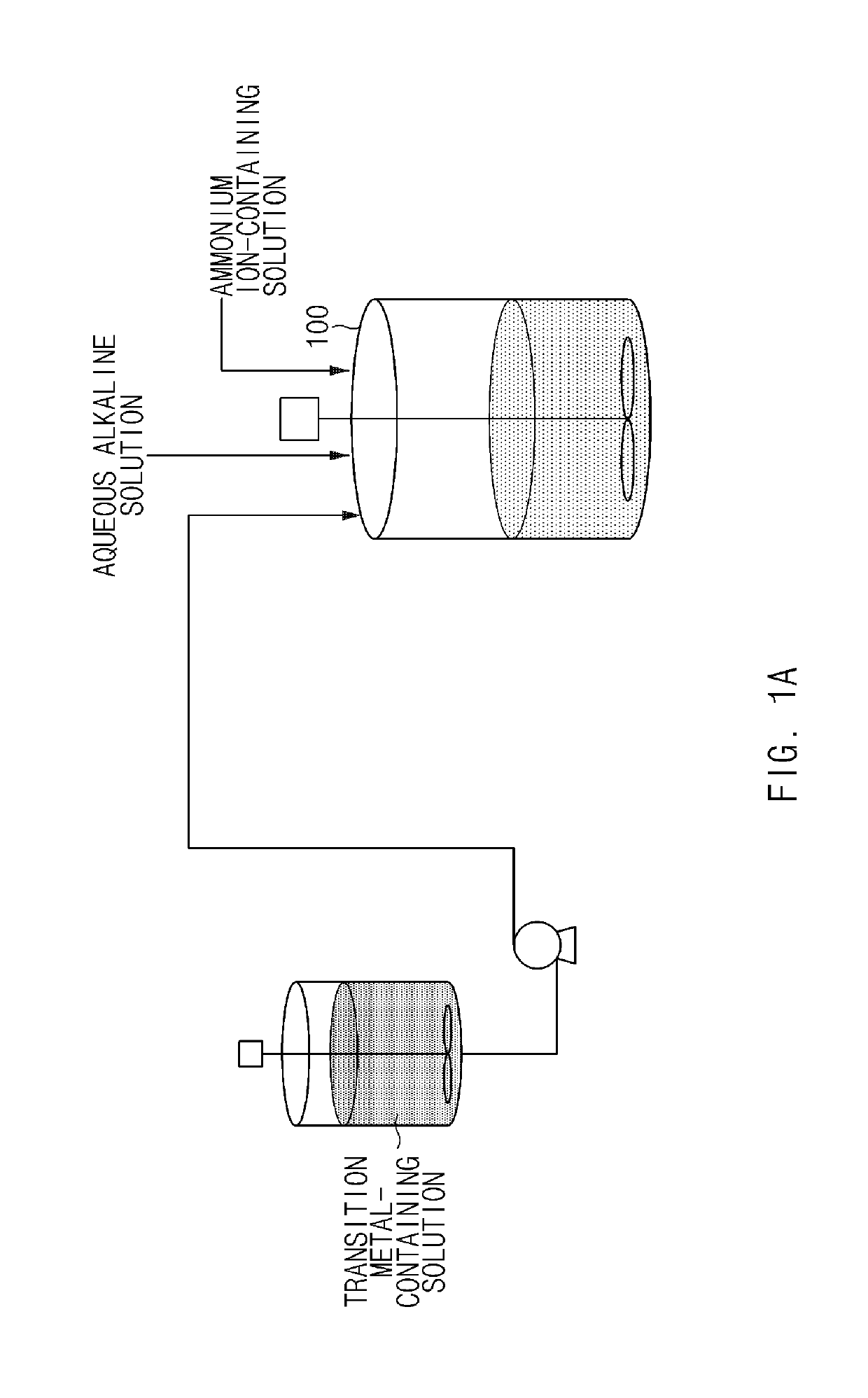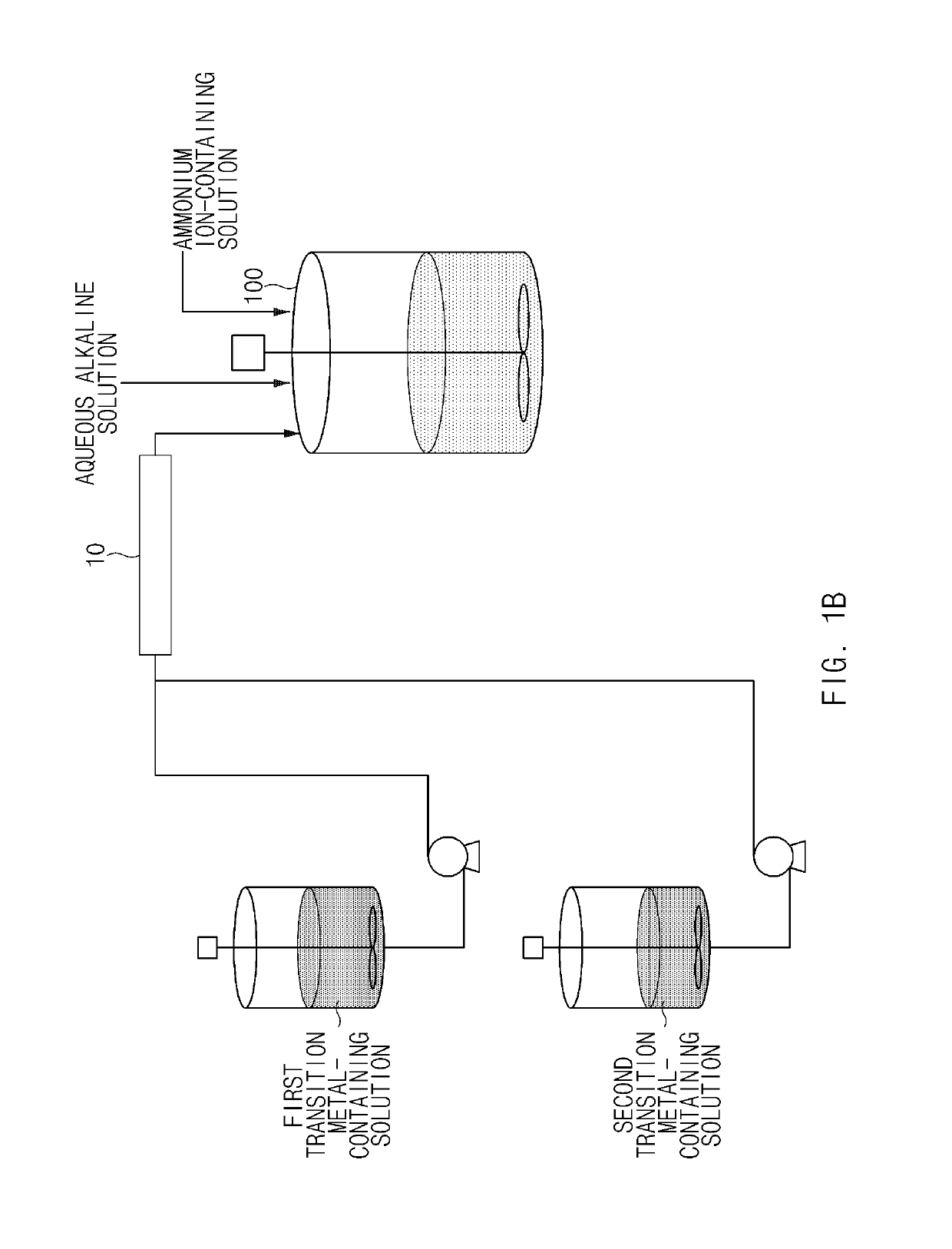Methods of Preparing Positive Electrode Active Material Precursor For Lithium Secondary Battery And Positive Electrode Active Material
a technology of active materials and lithium secondary batteries, which is applied in the direction of cell components, electrochemical generators, and nickel compounds, etc., can solve the problems of poor thermal stability, poor thermal properties of liniosub>2 /sub>, and the limitation of using a large amount of liniosub>2 as a power source for applications, so as to achieve the effect of improving the productivity reducing the size of particles, and improving the efficiency of positive electrode active materials
- Summary
- Abstract
- Description
- Claims
- Application Information
AI Technical Summary
Benefits of technology
Problems solved by technology
Method used
Image
Examples
example 1
[0111]NiSO4, CoSO4, and MnSO4 were mixed in water in amounts such that a molar ratio of nickel:cobalt:manganese was 80:10:10 to prepare a transition metal-containing solution with a concentration of 2M. A container containing the transition metal-containing solution was connected to a 20 L batch-type reactor set at 60° C. In addition, a 25 wt % NaOH aqueous solution and a 15 wt % NH4OH aqueous solution were prepared and connected to the reactor, respectively.
[0112]4 L of deionized water was put in the batch-type reactor, the reactor was then purged with nitrogen gas at a rate of 2 L / min to remove dissolved oxygen in the water and create a non-oxidizing atmosphere in the reactor. Thereafter, 20 ml of a 50 wt % NaOH aqueous solution and 500 mL of a 15 wt % NH4OH aqueous solution were added, and stirring was then performed at a speed of 500 rpm and a temperature of 60° C. to maintain a pH at 12.0.
[0113]Subsequently, the transition metal-containing solution, the NaOH aqueous solution, a...
example 2
[0116]As a transition metal-containing solution, NiSO4, CoSO4, and MnSO4 were mixed in water in amounts such that a molar ratio of nickel:cobalt:manganese was 90:5:5 to prepare a first transition metal-containing solution with a concentration of 2M, and NiSO4, CoSO4, and MnSO4 were mixed in water in amounts such that a molar ratio of nickel:cobalt:manganese was 50:25:25 to prepare a second transition metal-containing solution with a concentration of 2M. Containers containing the first and second transition metal-containing solutions were respectively connected to a static mixer, and a batch-type reactor (20 L) was connected to an outlet side of the static mixer. In addition, a 25 wt % NaOH aqueous solution and a 15 wt % NH4OH aqueous solution were prepared and connected to the reactor, respectively.
[0117]4 L of deionized water was put in the batch-type reactor, the reactor was then purged with nitrogen gas at a rate of 5 L / min to remove dissolved oxygen in the water and create a non...
example 3
[0119]A precursor having an average composition of Ni0.60Co0.20Mn0.20(OH)2 and a concentration gradient, in which Ni was gradually decreased and Co and Mn were gradually increased from the center of the particle to the surface thereof, was prepared in the same manner as in Example 2 except that the precursor having a concentration gradient was prepared by performing the reaction while changing the concentration of nickel of the transition metal-containing solution added to the reactor through the static mixer, the pH, and the flow of the NaOH aqueous solution as listed in Table 1.
PUM
| Property | Measurement | Unit |
|---|---|---|
| pH | aaaaa | aaaaa |
| pH | aaaaa | aaaaa |
| pH | aaaaa | aaaaa |
Abstract
Description
Claims
Application Information
 Login to View More
Login to View More - R&D
- Intellectual Property
- Life Sciences
- Materials
- Tech Scout
- Unparalleled Data Quality
- Higher Quality Content
- 60% Fewer Hallucinations
Browse by: Latest US Patents, China's latest patents, Technical Efficacy Thesaurus, Application Domain, Technology Topic, Popular Technical Reports.
© 2025 PatSnap. All rights reserved.Legal|Privacy policy|Modern Slavery Act Transparency Statement|Sitemap|About US| Contact US: help@patsnap.com



